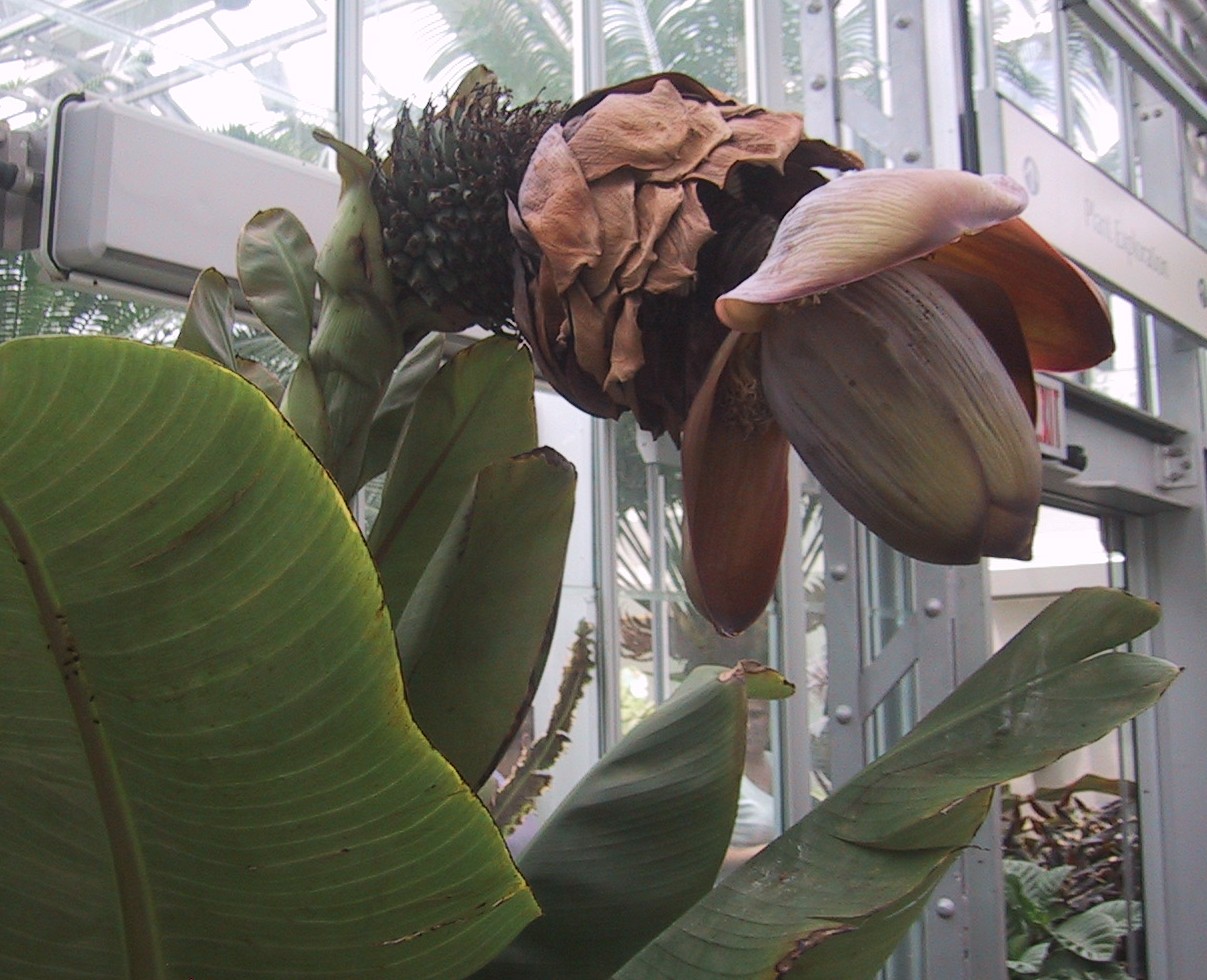- Ensete
image_caption = "Ensete superbum" at theUnited States Botanic Garden
regnum =Plantae
unranked_divisio =Angiosperms
unranked_classis =Monocots
unranked_ordo =Commelinids
ordo =Zingiberales
familia =Musaceae
genus = "Ensete"
genus_authority = Bruce
subdivision_ranks = Species
subdivision = See text.|"Ensete", or Enset, is one of three genera of
plant s in thebanana family,Musaceae , native to tropical regions ofAfrica andAsia .Domesticated enset in Ethiopia
"Enset provides more amount of foodstuff per unit area than most cereals. It is estimated that 40 to 60 enset plants occupying 250-375 sq. meters can provide enough food for a family of 5 to 6 people." – Country Information Brief,
FAO June 1995A traditional food plant in Africa, this little-known vegetable has potential to improve nutrition, boost food security, foster rural development and support sustainable landcare. [cite book |authorlink= |author=National Research Council |editor= |others= |title=Lost Crops of Africa: Volume II: Vegetables |origdate= |url=http://books.nap.edu/openbook.php?record_id=11763 |format= |accessdate=2008-07-17 |edition= |series=Lost Crops of Africa |volume=2 |date=2006-10-27 |publisher=National Academies Press |location= |isbn=978-0-309-10333-6 |oclc= |doi= |id= |pages= |chapter=Enset |chapterurl=http://books.nap.edu/openbook.php?record_id=11763&page=173 |quote= |ref= ]
Enset ("E. ventricosum") is commonly known as "false banana" for its close resemblance to the domesticated banana plant. It is
Ethiopia 's most importantroot crop , a traditional staple crop in the densely populated south and southwestern parts of Ethiopia. [Richard Pankhurst, "Economic History of Ethiopia" (Addis Ababa: Haile Selassie I University, 1968), p. 194. Pankhurst uses the taxononym "Musa ensete".] Its importance to the diet and economy of theGurage andSidama people s was first recorded byJerónimo Lobo . [Jerónimo Lobo, "The Itinerário of Jerónimo Lobo", translated by Donald M. Lockhart (London: Hakluyt Society, 1984), pp. 245f] The root is the main edible portion as its fruit is not edible. Each plant takes four to five years to mature, at which time a single root will give 40 kg of food. Due to the long period of time fromplanting toharvest , plantings need to be staggered over time, to ensure that there is enset available for harvest in every season. Enset will toleratedrought better than mostcereal crop s. Wild enset plants are produced fromseed s, while most domesticated plants are propagated from suckers. Up to 400 suckers can be produced from just one mother plant. In 1994 3,000 km² of enset were grown in Ethiopia, with a harvest estimated to be almost 10 tonnes per ha. Enset is often intercropped withsorghum .Taxonomy
The genus "Ensete" was first described by
Paul Fedorowitsch Horaninow (1796-1865) in his "Prodromus Monographiae Scitaminarum " of 1862 in which he created a single species, "Ensete edule". However, the genus did not receive general recognition until 1947 when it was revived byE. E. Cheesman in the first of a series of papers in the "Kew Bulletin " on the classification of the bananas, with a total of 25 species.Taxonomically, the genus "Ensete" has shrunk since Cheesman revived the genus. Cheesman acknowledged that field study might reveal synonymy and the most recent review of the genus by Simmonds (1960) listed just six. Recently the number has increased to seven as the Flora of
China has, not entirely convincingly, reinstated "Ensete wilsonii". There is one species inThailand , somewhat resembling "E. superbum", that has not been formally described, and possibly other Asian species.It is possible to separate "Ensete" into its African and Asian species.
;Africa:"
Ensete gilletii ":"Ensete homblei ":"Ensete perrieri " - endemic toMadagascar but intriguingly like the Asian "E. glaucum":"Ensete ventricosum " - Enset or "false banana", sometimes used in Ethiopian cuisine (particularlyGurage cuisine).;Asia:"
Ensete glaucum " - widespread in Asia from India to Papua New Guinea:"Ensete superbum " - Western Ghats of India:"Ensete wilsonii " -Yunnan , China, but doubtfully distinct from "E. glaucum":"Ensete" sp. "Thailand" - possibly a new species or a disjunct population of "E. superbum"See also
*
List of Southern African indigenous trees
*Gurage Notes
External links
* (1999): [http://www.users.globalnet.co.uk/~drc/ensete.htm]
* [http://davesgarden.com/pf/go/38383/ Dave's Garden] - Information on False Banana, Red Abyssinian Banana, Wild Banana (Ensete ventricosum)
* [http://www.africa.upenn.edu/eue_web/enset96.htm Enset as a crop] (UNEUE)
* [http://www.africa.upenn.edu/Hornet/Enset_Culture_19761.html Enset Culture] (UNEUE)
* [http://www.aaas.org/international/africa/enset/descrip.shtml American Association for the Advancement of Science] - The Tree Against Hunger: Enset-based Agricultural Systems in Ethiopia.
* [http://www.hardytropicals.co.uk/Bananas/Ensete_ventricosum_Murelii_Red_Banana.php Hardy Tropicals - Ensete Maurelli, The Red Abyssinian Banana]
* [http://www.treemail.nl/download/treebook5.pdf Five thousand years of sustainability? A case study on Gedeo land use.] PhD dissertation by Kippie Kanshie, T. of May 2002. ISBN 90-804443-6-7, Treemail publishers, 295 pp, 20 pages of color illustrations.
* [http://www.oxfamamerica.org/whatwedo/where_we_work/ethiopia/news_publications/art5760.html Oxfam] - Holes in the Safety Net
Wikimedia Foundation. 2010.

